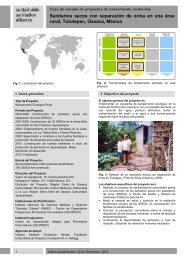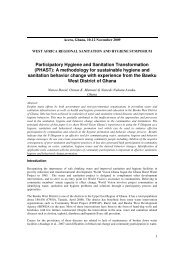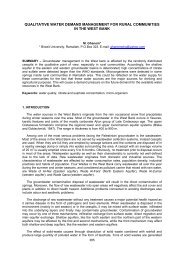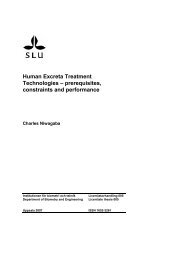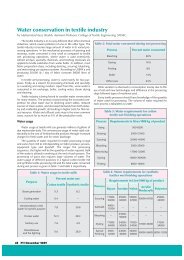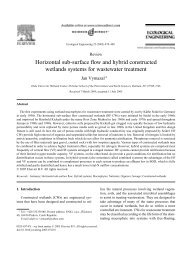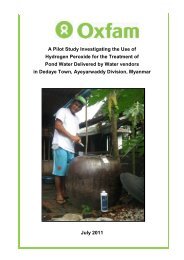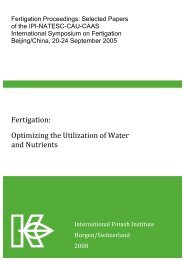Compilation of 13 factsheets on key sustainable sanitation ... - SSWM
Compilation of 13 factsheets on key sustainable sanitation ... - SSWM
Compilation of 13 factsheets on key sustainable sanitation ... - SSWM
Create successful ePaper yourself
Turn your PDF publications into a flip-book with our unique Google optimized e-Paper software.
not just <strong>on</strong>e or two standard opti<strong>on</strong>s, but the locally adapted<br />
range <str<strong>on</strong>g>of</str<strong>on</strong>g> feasible opti<strong>on</strong>s – as a basis for an informed<br />
choice. The inclusi<strong>on</strong> <str<strong>on</strong>g>of</str<strong>on</strong>g> all feasible opti<strong>on</strong>s is <str<strong>on</strong>g>of</str<strong>on</strong>g> <strong>key</strong><br />
importance to the process <str<strong>on</strong>g>of</str<strong>on</strong>g> informing decisi<strong>on</strong> makers and<br />
planners <str<strong>on</strong>g>of</str<strong>on</strong>g> the potential range <str<strong>on</strong>g>of</str<strong>on</strong>g> sanitati<strong>on</strong> opti<strong>on</strong>s in a<br />
single c<strong>on</strong>text.<br />
Hence, financial and ec<strong>on</strong>omic analyses need to provide<br />
the decisi<strong>on</strong> maker with specific informati<strong>on</strong> that helps to<br />
judge the real costs and sustainability <str<strong>on</strong>g>of</str<strong>on</strong>g> different<br />
technologies. This means not just knowing the purchase<br />
price or capital costs but also operati<strong>on</strong> and maintenance<br />
(O&M) costs, and the associated additi<strong>on</strong>al (direct or<br />
indirect) benefits to the user such as health, comfort and<br />
protecti<strong>on</strong> <str<strong>on</strong>g>of</str<strong>on</strong>g> the local envir<strong>on</strong>ment.<br />
An assessment <str<strong>on</strong>g>of</str<strong>on</strong>g> the benefits <str<strong>on</strong>g>of</str<strong>on</strong>g> improved sanitati<strong>on</strong> may<br />
be applied to the following activities:<br />
a) Policy decisi<strong>on</strong>s<br />
Results from an ec<strong>on</strong>omic analysis can play an important<br />
role in influencing political decisi<strong>on</strong>s about the need to<br />
invest in improving sanitati<strong>on</strong> (cost benefit analysis).<br />
Analyses <str<strong>on</strong>g>of</str<strong>on</strong>g> ec<strong>on</strong>omic benefits can support sanitati<strong>on</strong><br />
advocacy efforts, with the aim <str<strong>on</strong>g>of</str<strong>on</strong>g> increasing political support<br />
and potentially household and community knowledge,<br />
leading to greater prioritisati<strong>on</strong> <str<strong>on</strong>g>of</str<strong>on</strong>g> sanitati<strong>on</strong> and hygiene.<br />
Figure 2: Uschi Eid (UNSAGB) giving a speech <strong>on</strong> the importance<br />
<str<strong>on</strong>g>of</str<strong>on</strong>g> sanitati<strong>on</strong> in the plenary sessi<strong>on</strong> <str<strong>on</strong>g>of</str<strong>on</strong>g> the Sec<strong>on</strong>d Africa Water<br />
Week in South Africa (source: A. Panesar, 2009).<br />
b) Sanitati<strong>on</strong> programming<br />
Ec<strong>on</strong>omic analysis may also be required to justify the<br />
rati<strong>on</strong>ale for a project or programme in the first instance. On<br />
the basis that there is ec<strong>on</strong>omic justificati<strong>on</strong>, financial<br />
analysis is used to compare l<strong>on</strong>g term costs <str<strong>on</strong>g>of</str<strong>on</strong>g> different<br />
alternative soluti<strong>on</strong>s (cost effectiveness) taking into account<br />
capital investment (CAPEX), operati<strong>on</strong>al and maintenance<br />
expenditures (OPEX) and capital maintenance expenditures<br />
(CapManEx).<br />
c) Project design<br />
Sound financial analysis is fundamental for good project<br />
design. To be able to appropriately cost a project within a<br />
given budget, engineers need to base estimates <strong>on</strong><br />
accurate unit costs and have a clear understanding <str<strong>on</strong>g>of</str<strong>on</strong>g> the<br />
uncertainties surrounding data sets.<br />
Clearly, financial and ec<strong>on</strong>omic evidence has value for a<br />
range <str<strong>on</strong>g>of</str<strong>on</strong>g> target groups – groups that have different roles<br />
and levels <str<strong>on</strong>g>of</str<strong>on</strong>g> influence in decisi<strong>on</strong>s <strong>on</strong> choice <str<strong>on</strong>g>of</str<strong>on</strong>g> sanitati<strong>on</strong><br />
technology or programme implementati<strong>on</strong>:<br />
• For those c<strong>on</strong>trolling budgets for allocati<strong>on</strong> to sanitati<strong>on</strong><br />
programmes the primary c<strong>on</strong>cern is for overall<br />
programme efficiency; including household, community<br />
and external benefits <str<strong>on</strong>g>of</str<strong>on</strong>g> improved sanitati<strong>on</strong>. Also<br />
important to policy makers are the overall financing<br />
needs for different programme comp<strong>on</strong>ents and the<br />
different sources from which to finance these<br />
programmes.<br />
• For implementing agencies c<strong>on</strong>cern will be not <strong>on</strong>ly the<br />
overall gains, but also the equitable distributi<strong>on</strong> <str<strong>on</strong>g>of</str<strong>on</strong>g> the<br />
programme gains, and targeting <str<strong>on</strong>g>of</str<strong>on</strong>g> subsidies to poor and<br />
vulnerable groups.<br />
• For the ultimate beneficiaries – the households – the<br />
interest will be <strong>on</strong> private benefits and the investment and<br />
running costs that must be covered by the household.<br />
Installati<strong>on</strong> cost (US$) 3 Financial analysis: elements and indicators<br />
Financial analysis focuses <strong>on</strong> expenditures and revenue<br />
streams and c<strong>on</strong>siders subsets <str<strong>on</strong>g>of</str<strong>on</strong>g> data that are identifiable<br />
as financial transacti<strong>on</strong>s. Financial assessment <str<strong>on</strong>g>of</str<strong>on</strong>g> sanitati<strong>on</strong><br />
opti<strong>on</strong>s c<strong>on</strong>siders capital expenditure (CAPEX), operati<strong>on</strong>al<br />
expenditure (OPEX) and capital maintenance expenditure<br />
(CapManEx).<br />
To ensure sustainability, investors <str<strong>on</strong>g>of</str<strong>on</strong>g> sanitati<strong>on</strong> systems<br />
such as utilities or local authorities need to c<strong>on</strong>sider the<br />
recurring costs for the operati<strong>on</strong> and maintenance to ensure<br />
sustainability and not <strong>on</strong>ly the initial investment costs. In<br />
additi<strong>on</strong>, there is a need to take into c<strong>on</strong>siderati<strong>on</strong> service<br />
charges and other sources <str<strong>on</strong>g>of</str<strong>on</strong>g> revenue such as from the sale<br />
<str<strong>on</strong>g>of</str<strong>on</strong>g> by-products (e.g. treated wastewater for irrigati<strong>on</strong>,<br />
compost or digested sludge, or electricity derived from<br />
biogas).The capital cost <str<strong>on</strong>g>of</str<strong>on</strong>g> different sanitati<strong>on</strong> opti<strong>on</strong>s is a<br />
very important variable for the decisi<strong>on</strong> whether to invest or<br />
not, and for the choice <str<strong>on</strong>g>of</str<strong>on</strong>g> technology. Households, in<br />
particular poor <strong>on</strong>es, are highly sensitive to price in their<br />
purchase decisi<strong>on</strong>s, especially for sanitati<strong>on</strong> which is not<br />
usually a priority item.<br />
1600<br />
1400<br />
1200<br />
1000<br />
800<br />
600<br />
400<br />
200<br />
0<br />
1500<br />
400<br />
Flush to<br />
sewer or<br />
septic tank<br />
1500<br />
675<br />
Urban UD<br />
dry or wet<br />
toilets<br />
600<br />
75<br />
Flush to<br />
septic tank<br />
and<br />
c<strong>on</strong>dominal<br />
sewers<br />
35 - 400<br />
40 - 220<br />
UDDT VIP Basic pit<br />
latrine w/<br />
slab<br />
10 - 50 10 - 40 12 - 40<br />
Soil Communal<br />
composting toilet (50<br />
toilet pers<strong>on</strong>s /<br />
seat)<br />
Figure 3: Example capital cost range for different sanitati<strong>on</strong> opti<strong>on</strong>s,<br />
per unit (source: Rosemarin et al., 2005). Note that most <str<strong>on</strong>g>of</str<strong>on</strong>g> these<br />
opti<strong>on</strong>s do not cover the whole sanitati<strong>on</strong> chain.<br />
As shown in Figure 3, capital costs vary between different<br />
sanitati<strong>on</strong> opti<strong>on</strong>s, the project scale and even within <strong>on</strong>e<br />
technology type CAPEX includes both hardware for<br />
Finance and ec<strong>on</strong>omics: Working Group 2 - page 2



